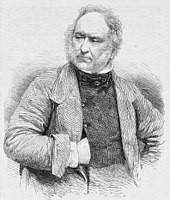John Frederick Herring, later with the addition Sr. for Senior, was born the son of a merchant in London. John grew up in London and developed an intense interest in horses and painting. The city offered few prospects for the young man and so, at a young 18, John moved to Doncaster in the north of England. There he began to paint and met his future wife. At first John designed the signs of inns and later the exteriors of carriages. John Frederick Herring then got a job as a coachman and in his spare time painted the horses he surrounded himself with. He sold his paintings of animals to the inns he drove to and soon became a regional celebrity under the name of Artist Coachman. In the early 19th century, traveling by carriage was common in British society. Many passengers came from wealthy families and were members of the landed gentry. Guests who had a practiced eye for artistic talent and commissioned Herring to paint them. Popular subjects included scenes of rural life and depictions of noble racehorses. John gained experience and moved back to London to establish himself as an artist in the metropolis.
In London, the painter experienced difficult economic times. John met the painter Abraham Cooper and with his help improved his skills. Herring succeeded in the change and he received commissions from the environment of the French royal family, which led to a stay in Paris. Back in England, more commissioned work followed. John specialized in painting animals and liked to depict sporting events with horses. From his palette he chose warm earth tones, which he applied with fine brushstrokes. His impressive and vivid depictions of racehorses, cows and ducks, as well as his scenic scenes caught the attention of Queen Victoria. The queen commissioned work from the painter and remained one of his most important supporters throughout his life.
At the age of almost 60, John Frederick Herring retired from lively London. He moved to rural Kent and led the quiet life of a country gentleman. Painting continued to accompany him. The artist no longer painted racehorses, but he deepened and refined his technique in landscape painting. The rural idyll was the setting for the famous hunting scenes for which John Frederick Herring Sr. became famous. With his wife Ann, John had four sons and two daughters. Three of his sons also became painters and John added Sr to his signature from then on. The couple's two daughters married painters and added more artists to the Herring family.
×





.jpg)
.jpg)
.jpg)
.jpg)
.jpg)
.jpg)
.jpg)
.jpg)
.jpg)
.jpg)
.jpg)
.jpg)
.jpg)
.jpg)
.jpg)
.jpg)
.jpg)
.jpg)
.jpg)
.jpg)
.jpg)
.jpg)
.jpg)
.jpg)
.jpg)
.jpg)
.jpg)
.jpg)
.jpg)
.jpg)
.jpg)
.jpg)
.jpg)
.jpg)
.jpg)
.jpg)
.jpg)
.jpg)
.jpg)
.jpg)
.jpg)
.jpg)
.jpg)
.jpg)
.jpg)
.jpg)
.jpg)
.jpg)
.jpg)
.jpg)
.jpg)
.jpg)
.jpg)
.jpg)
.jpg)
.jpg)
.jpg)
.jpg)
.jpg)
.jpg)
.jpg)
.jpg)
.jpg)
.jpg)
.jpg)
.jpg)
.jpg)
.jpg)
.jpg)
.jpg)
.jpg)
.jpg)
.jpg)
.jpg)
.jpg)
.jpg)
.jpg)
.jpg)
.jpg)
.jpg)
_-_(MeisterDrucke-1108234).jpg)
_-_(MeisterDrucke-1108234).jpg)
_-_(MeisterDrucke-1098312).jpg)
_-_(MeisterDrucke-1098312).jpg)
.jpg)
.jpg)
.jpg)
.jpg)
_-_(MeisterDrucke-1132508).jpg)
_-_(MeisterDrucke-1132508).jpg)
.jpg)
.jpg)
.jpg)
.jpg)
.jpg)
.jpg)
.jpg)
.jpg)
.jpg)
.jpg)
_-_(MeisterDrucke-1108042).jpg)
_-_(MeisterDrucke-1108042).jpg)
.jpg)
.jpg)
.jpg)
.jpg)
.jpg)
.jpg)
.jpg)
.jpg)
.jpg)
.jpg)
.jpg)
.jpg)
_-_(MeisterDrucke-1094266).jpg)
_-_(MeisterDrucke-1094266).jpg)
.jpg)
.jpg)
.jpg)
.jpg)
.jpg)
.jpg)
.jpg)
.jpg)
.jpg)
.jpg)
.jpg)
.jpg)
.jpg)
.jpg)
.jpg)
.jpg)
.jpg)
.jpg)
.jpg)
.jpg)
.jpg)
.jpg)
.jpg)
.jpg)
.jpg)
.jpg)
.jpg)
.jpg)
.jpg)
.jpg)
.jpg)
.jpg)
.jpg)
.jpg)
.jpg)
.jpg)
.jpg)
.jpg)
.jpg)
.jpg)
.jpg)
.jpg)
.jpg)
.jpg)
.jpg)
.jpg)
.jpg)
.jpg)
.jpg)
.jpg)
.jpg)
.jpg)
.jpg)
.jpg)
.jpg)
.jpg)
.jpg)
.jpg)
_-_(MeisterDrucke-1081143).jpg)
_-_(MeisterDrucke-1081143).jpg)
.jpg)
.jpg)
_-_(MeisterDrucke-1098567).jpg)
_-_(MeisterDrucke-1098567).jpg)
.jpg)
.jpg)
.jpg)
.jpg)
.jpg)
.jpg)
.jpg)
.jpg)
.jpg)
.jpg)
.jpg)
.jpg)
.jpg)
.jpg)
.jpg)
.jpg)
.jpg)
.jpg)
_-_(MeisterDrucke-1130690).jpg)
_-_(MeisterDrucke-1130690).jpg)






